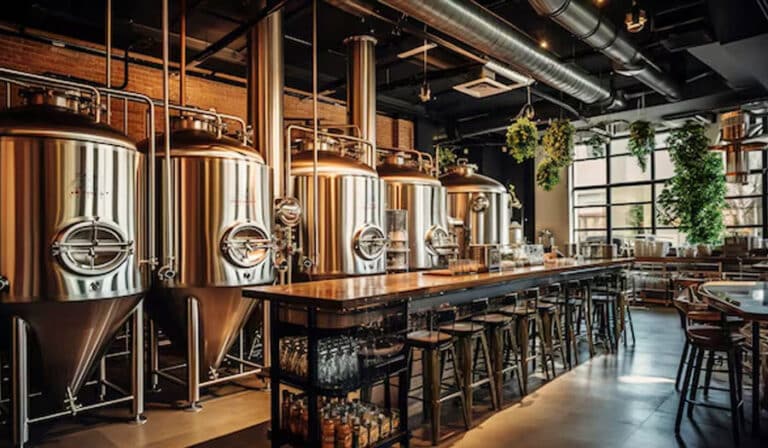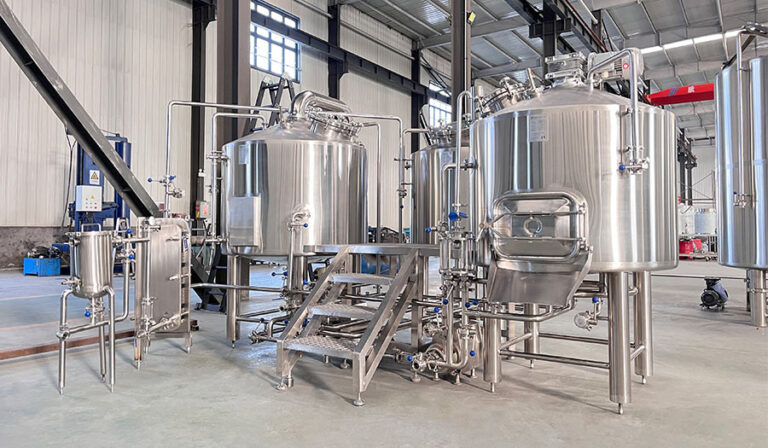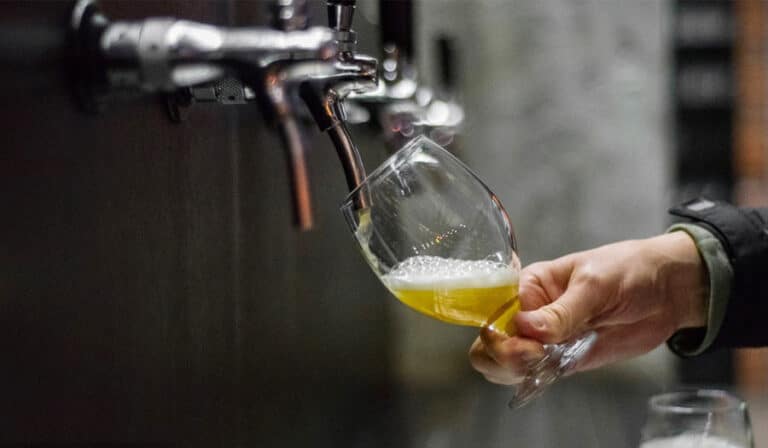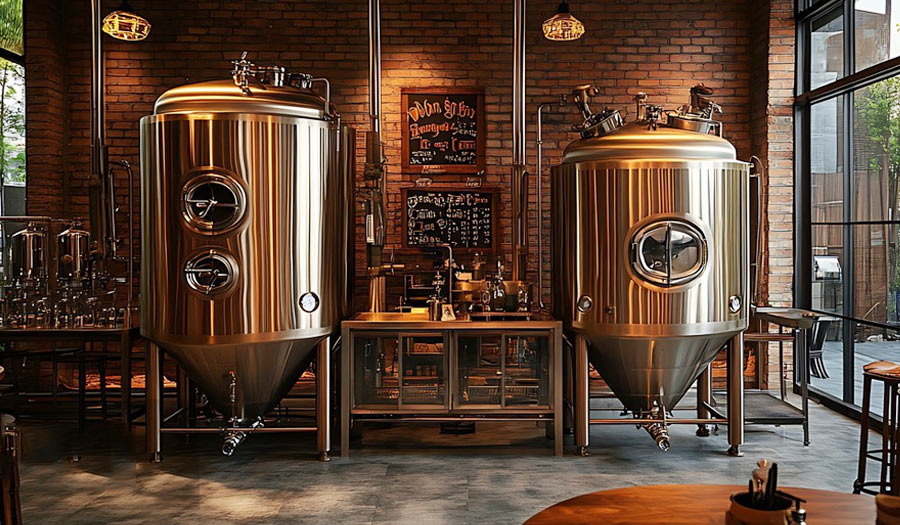No sector da restauração, o fornecimento de cerveja artesanal de alta qualidade tornou-se uma das chaves para atrair clientes e aumentar o valor da marca dos restaurantes. Com a popularidade da cerveja artesanal, os restaurantes não só precisam de fornecer um menu de refeições, como também precisam de ser capazes de garantir a estabilidade do sabor e a excelente qualidade de cada copo de cerveja. Se está a pensar em abrir um serviço de fabrico de cerveja num restaurante, talvez queira saber que equipamento é necessário para o fabrico de cerveja num restaurante. A escolha do equipamento correto para a produção de cerveja pode não só melhorar a eficiência da produção e reduzir os custos de mão de obra, mas também garantir que cada garrafa de cerveja cumpre os mais elevados padrões de qualidade.
Que equipamento é necessário para a melhor preparação de cerveja num restaurante?
Sistema de fabrico de cerveja
A panela de fermentação é o equipamento principal do fabrico de cerveja. É utilizada principalmente para sacarificar o malte e ferver o lúpulo. É uma parte crucial de todo o processo de fabrico da cerveja, responsável pela conversão do amido do malte em açúcar e pela sua fervura com o lúpulo para libertar o aroma e o amargor da cerveja.
- Tina de mosto: A caldeira de trituração é utilizada para misturar o malte triturado com água quente e, após um período de aquecimento, o amido do malte é convertido em açúcar fermentável. O controlo da temperatura é a principal função da caldeira de trituração, sendo normalmente necessário um sistema preciso de controlo da temperatura.
- Caldeira de ebulição: A caldeira de ebulição é utilizada para ferver o mosto sacarificado com lúpulo. O processo de fervura não só melhora o amargor e o aroma do lúpulo, como também aumenta consideravelmente a clareza do lúpulo.

Tanque de fermentação
O cuba de fermentação é um dos principais equipamentos do processo de fabrico da cerveja, utilizado principalmente na fase de fermentação. É utilizado para a fermentação inicial da cerveja, normalmente fermentada na cuba durante uma a duas semanas, durante as quais a levedura converte o açúcar em álcool. Se a escala for alargada, podem ser necessárias várias cubas de fermentação para vários lotes da produção principal. A fermentação proporciona um ambiente fechado, com temperatura controlada, que permite à cerveja converter os açúcares em álcool e libertar gases. O tamanho e a composição do tanque de fermentação afectam diretamente o sabor, o aroma e a eficiência da produção da cerveja.
Sistema de arrefecimento
O sistema de arrefecimento desempenha um papel vital no processo de fabrico da cerveja. Durante o processo de fabrico da cerveja, especialmente na fase de fermentação, a temperatura da cerveja tem de ser rigorosamente controlada. Uma temperatura demasiado alta ou demasiado baixa afectará a atividade da cerveja e o sabor final da mesma. A camisa de arrefecimento é uma camada de dispositivo de arrefecimento que envolve o tanque de fermentação ou o pote de fermentação. Faz circular o líquido de refrigeração para reduzir o calor gerado durante o processo de fermentação e manter a temperatura ideal de fermentação. O refrigerador é utilizado para arrefecer rapidamente o mosto fervido para evitar que as temperaturas elevadas tenham efeitos adversos na levedura. Normalmente, utiliza o princípio da troca de calor para reduzir rapidamente o mosto da temperatura de ebulição para uma temperatura adequada para a fermentação.
Sistema de filtragem
O processo de filtração da cerveja é um passo fundamental para garantir a sua clareza e limpidez. Embora alguns métodos de fabrico de cerveja (como a cerveja turva) não exijam uma filtragem excessiva, a maioria das cervejas caseiras de restaurantes continua a necessitar de equipamento de filtragem para aumentar a matéria insolúvel. Após a conclusão da fermentação, o filtro grosso pode remover partículas grandes da cerveja, como o malte residual ou a levedura. Os filtros finos são utilizados para remover a matéria fina em suspensão para garantir a clareza da cerveja. Os métodos de filtração mais comuns incluem a filtração por membrana e a filtração por carvão ativado.
Quanto custa o equipamento de fabrico de cerveja para restaurantes?
Os preços do equipamento de fabrico de cerveja para restaurantes variam muito, dependendo principalmente da capacidade, marca, função, grau de automatização e requisitos de personalização do equipamento. De um modo geral, quando os restaurantes escolhem o equipamento, determinam o tipo de equipamento e a gama de preços com base na escala de fabrico da cerveja (pequena, média, grande). Eis os preços de referência de alguns equipamentos comuns:
Cervejaria
- Pequena panela de fabrico de cerveja (5-10 galões / 19-38L): Adequada para pequenos restaurantes ou bares, normalmente utilizada para a produção de pequenos lotes de cerveja artesanal. O preço é de cerca de $2,000 - $5,000.
- Panela de fabrico de cerveja média (15-30 galões / 57-114L): Adequada para restaurantes de pequena e média dimensão, capaz de satisfazer as necessidades diárias, o preço situa-se normalmente entre $7,000 - $15,000*.
- Grandes panelas de fabrico de cerveja (50-100 galões / 190-380L): Adequadas para restaurantes maiores ou cervejarias artesanais, com elevada capacidade de produção, e os preços situam-se aproximadamente entre $20,000 - $50,000.
Tanques de fermentação
- Pequenos tanques de fermentação (5-15 galões / 19-57L): Adequados para a produção de cerveja em pequena escala, os preços rondam os $1,000 - $3,000.
- Tanques de fermentação médios (30-50 galões / 114-190L): Adequados para restaurantes ou bares de média dimensão, os preços situam-se normalmente entre $3,000 - $8,000.
- Grandes tanques de fermentação (100 galões / 380L e acima): Adequado para restaurantes de grande volume ou cervejarias artesanais, os preços são de cerca de $10.000 - $25.000.
Sistema de arrefecimento
- Serpentina de arrefecimento/Camisa de arrefecimento (para caldeiras de fermentação e fermentadores): Os preços situam-se normalmente entre $1,000 - $4,000, dependendo da complexidade do sistema e da capacidade de arrefecimento.
- Sistema de arrefecimento totalmente automático: Sistema de arrefecimento topo de gama para uma regulação eficiente da temperatura, os preços situam-se normalmente entre $5,000 - $15,000.
Equipamento de filtragem
- Sistema de filtragem simples: Adequado para pequenos restaurantes, os preços são cerca de $500 - $2,000.
- Sistema de filtragem fina de alta eficiência: Adequado para restaurantes de média e grande dimensão, os preços situam-se normalmente entre $3,000 - $8,000.

Diferentes tipos de equipamento de fabrico de cerveja para restaurantes à venda
|
Tipo de equipamento |
Descrição |
|
Equipamento para microcervejarias |
Essencial para as operações de fabrico de cerveja, a Micet é especializada em sistemas de fabrico de cerveja micro e industrial |
|
Equipamento para nano-cervejarias |
Adequado para aspirantes a vinicultores profissionais ou cervejeiros de pequena escala, oferecendo uma entrada acessível na indústria cervejeira |
|
Equipamento para cervejarias comerciais |
Concebidos para operações de fabrico de cerveja de maior dimensão, estes sistemas são feitos à medida para aplicações comerciais |
|
Equipamento para cervejaria de 100L |
Ideal para cervejeiros artesanais e caseiros, este sistema foi concebido para a produção de cerveja em pequena escala |
|
Equipamento para cervejaria de 200L |
Um conjunto de equipamento profissional para a produção de cerveja artesanal, adequado para operações de fabrico de cerveja moderadas |
|
Equipamento para cervejaria de 300L |
Posicionado entre o equipamento de fabrico de cerveja caseira e o equipamento de microcervejaria, adequado para operações de fabrico de cerveja nano |
|
Equipamento para cervejaria 500L |
Sistema de controlo totalmente automatizado, utilizado principalmente em pequenas microcervejarias independentes |
|
Equipamento para cervejaria 700L |
Inclui um sistema completo com moinho, triturador, fermentação, arrefecimento, controlo e sistemas CIP, fabricados em aço inoxidável de alta qualidade |
Aspectos a ter em conta na compra de equipamento de cerveja
Qualidade do equipamento
A qualidade do seu equipamento de fabrico de cerveja pode ter um impacto direto no sabor do seu produto e no sucesso da sua cerveja no mercado. Mesmo que seja um cervejeiro experiente, é importante verificar a qualidade de determinado equipamento antes de o comprar. Escolha equipamento de alta qualidade e duradouro e investigue as compras em grandes quantidades antes de tomar decisões importantes. Além disso, vale a pena planear quem fará a manutenção do equipamento para garantir que está familiarizado com o processo de manutenção.
Espaço disponível
A capacidade da sua fábrica de cerveja é limitada pelo espaço em que funciona. Muitas fábricas de cerveja funcionam em armazéns para produzir cerveja em grande escala. Considere o espaço necessário para o bar e/ou cozinha, e considere o espaço de trabalho para os cervejeiros e empregados de balcão. Afinal, terá de instalar instalações como saneamento, permutadores de calor e recipientes separados para a produção de todas as suas cervejas. Um espaço ideal será conveniente para clientes e empregados e permitirá que o seu negócio funcione com a máxima eficiência.
Utilização e limpeza a longo prazo
O equipamento de fabrico de cerveja em aço inoxidável durará muito tempo se for limpo correta e regularmente. Por exemplo, a manutenção constante dos tanques de fermentação garantirá que estes conseguem manter as temperaturas de fermentação e produzir o sabor exato que pretende.
Fornecedores de cerveja
Após a aquisição do equipamento de fabrico de cerveja, o serviço pós-venda e o apoio técnico são essenciais. Equipamento de fabrico de cerveja podem avariar ou necessitar de manutenção regular, pelo que é importante escolher um fornecedor fiável e garantir que este presta um serviço pós-venda de qualidade.

Vantagens do equipamento de fabrico de cerveja para restaurantes do Grupo Micet
|
Tipo de equipamento |
Benefícios |
|
Equipamento para microcervejarias |
Fornece as ferramentas essenciais para a produção de cerveja à escala micro e industrial, melhorando as capacidades de produção de cerveja e a variedade de produtos |
|
Equipamento para nano-cervejarias |
Oferece uma solução económica para aspirantes a cervejeiros profissionais, permitindo a produção de variedades de cerveja únicas e experimentais |
|
Equipamento para cervejarias comerciais |
Concebida à medida para operações de maior dimensão, garantindo uma produção de elevado volume com qualidade consistente, ideal para expandir o alcance do mercado |
|
Equipamento para cervejaria de 100L |
Especialmente concebido para cervejeiros artesanais e caseiros, perfeito para a produção de cerveja em pequena escala e para experiências pessoais |
|
Equipamento para cervejaria de 200L |
Faz a ponte entre as operações comerciais de pequena escala e as de maior dimensão, permitindo uma produção moderada de cerveja artesanal |
|
Equipamento para cervejaria de 300L |
Adequado para a produção de cerveja nano, proporcionando um equilíbrio entre a produção de cerveja caseira e as balanças de microcervejaria para uma produção de cerveja versátil |
|
Equipamento para cervejaria 500L |
Dispõe de um controlo totalmente automatizado, ideal para microcervejarias independentes que se concentram na produção eficiente e consistente de cerveja |
|
Equipamento para cervejaria 700L |
Inclui sistemas de fabrico de cerveja abrangentes, como moinho, trituração, fermentação e arrefecimento, para satisfazer as necessidades de fabrico de cerveja em grande escala |
FAQ
Que equipamento é utilizado no processo de fabrico da cerveja?
Para fabricar cerveja, é necessário um conjunto de equipamento especializado. Existem muitas máquinas e itens únicos na sua lista, incluindo fermentadores, tanques de propagação de levedura, moedores de malte, panelas de fermentação, sistemas piloto, bombas de mosto, geradores de vapor e permutadores de calor. Também precisa de lúpulo, trigo, levedura e quaisquer outros ingredientes que queira adicionar para dar sabor à cerveja.
Quanto tempo demora o equipamento de um restaurante a produzir cerveja?
Todo o processo de fabrico da cerveja inclui, grosso modo, o mosto, a fermentação e a maturação. O processo de brassagem demora normalmente 6-8 horas e a fermentação pode demorar 1-3 semanas, dependendo do tipo de cerveja que está a ser fabricada.
Como escolher o fermentador certo?
A escolha do fermentador depende principalmente da escala de produção do restaurante, do tipo de levedura selecionada e do tempo de fermentação. O material mais comum do fermentador é o aço inoxidável, porque não só é robusto e durável, como também é fácil de limpar. Adequar a capacidade da panela de fermentação. A capacidade do fermentador deve ser maior do que a da panela de fermentação para garantir que a cerveja tem espaço suficiente para se expandir durante o processo de fermentação.
O custo de manutenção do equipamento de cerveja é elevado?
O custo de manutenção do equipamento de cerveja depende da complexidade do equipamento, da frequência de utilização e do grau de automatização. As tarefas de manutenção mais comuns incluem a limpeza do equipamento, a verificação do sistema de controlo da temperatura, a substituição de filtros, etc. O equipamento totalmente automático tem custos de manutenção relativamente elevados, mas a sua eficiência operacional e consistência compensam normalmente os custos de manutenção adicionais.




